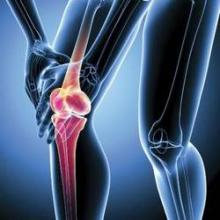Intra-articular treatments appear to be more effective than oral therapies for knee osteoarthritis, but that may be due to their greater placebo effect, according to a report published online Jan. 5, 2015, in the Annals of Internal Medicine.
Until now, the relative effectiveness of various OA treatments has been difficult to discern, in part because few studies have offered direct head-to-head comparisons, and traditional meta-analysis techniques “cannot integrate all of the evidence from several comparators.” So researchers used a network meta-analysis design that enabled multiple comparisons among five oral agents (acetaminophen, diclofenac, ibuprofen, naproxen, and celecoxib), two intra-articular agents (corticosteroids and hyaluronic acid), and two placebos. They included 137 randomized controlled trials involving 33,243 adults with primary knee OA who were treated for at least 3 months between 1980 and 2014, said Dr. Raveendhara R. Bannuru, director of the center for treatment comparison and integrative analysis, at Tufts Medical Center's Institute for Clinical Research and Health Policy Studies, Boston, and his associates.
All the treatments except acetaminophen produced clinically significant improvement in pain. Both of the intra-articular treatments, with effect sizes of up to 0.63, were superior to all of the oral treatments, with effect sizes as low as 0.18. Most striking was the finding that intra-articular hyaluronic acid was the most effective treatment of all, since it is “generally considered by expert panels to be minimally effective.” But this may be because intra-articular delivery itself was found to have a significant placebo effect (effect size of 0.29) – a result that traditional meta-analysis could not have revealed, the investigators said (Ann. Intern. Med. 2015 Jan. 5 [doi:10.7326/M14-1231]).
The study findings raise important questions about whether this is a true placebo response or a physiologic effect from injecting fluid into the knee joint. “Regardless of the mechanism of the apparent benefit attributable to needle placement in the knee, the practical reality is that this procedure contributes to the overall benefit conferred in clinical practice,” Dr. Bannuru and his associates noted.
“This information, along with the safety profiles and relative costs of [the] treatments, should be helpful to clinicians when making care decisions tailored to individual patient needs,” they wrote.
This study was supported by a grant from the U.S. Agency for Healthcare Research and Quality. Dr. Bannuru’s associates reported ties to the Patient-Centered Outcomes Research Institute, the National Center for Complementary and Alternative Medicine, the European League Against Rheumatism, Croma, Flexion Therapeutics, and Bioventus.


